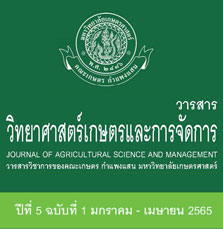รูปแบบของการให้น้ำที่มีผลต่อการก่อโรคและการขยายพันธุ์ของไส้เดือนฝอยรากปมข้าว Meloidogyne graminicola ในข้าวพันธุ์สุรินทร์ 1
คำสำคัญ:
ข้าว, โรครากปม, รูปแบบแบบให้น้ำ, การก่อโรค, การขยายพันธุ์ของไส้เดือยฝอยบทคัดย่อ
ข้าว (Oryza sativa L.) เป็นพืชเศรษฐกิจสำคัญของประเทศไทย ปัญหาสำคัญในพื้นที่ที่มีการเพาะปลูก เกิดจากโรครากปมที่มีสาเหตุจากไส้เดือนฝอยรากปม Meloidogyne graminicola งานวิจัยนี้ได้ทำการศึกษารูปแบบการให้น้ำ ที่มีผลต่อการก่อโรคและการขยายพันธุ์ของไส้เดือนฝอยรากปมข้าวในข้าวไทยพันธุ์สุรินทร์ 1 ในสภาพเรือนทดลอง ทำการทดสอบแบบของการให้น้ำ 4 กรรมวิธี ได้แก่ การให้น้ำแบบท่วมขัง แบบเปียกสลับแห้ง 1 สัปดาห์ แบบเปียกสลับแห้ง 2 สัปดาห์ และแบบสภาพดินแห้ง ผลการทดลองพบว่าไส้เดือนฝอยรากปมข้าวลดการเจริญและปริมาณผลผลิตของข้าวพันธุ์ดังกล่าวในทุกรูปแบบการให้น้ำ โดยมีดัชนีการเกิดปมและผลผลิตลดลงมากที่สุดในข้าวที่ปลูกในสภาพดินแห้ง ในขณะที่จำนวนประชากรของไส้เดือนฝอยในรากข้าว ณ วันเก็บเกี่ยว พบมากที่สุดในกรรมวิธีการให้น้ำแบบเปียกสลับแห้ง 2 สัปดาห์ ผลการวิจัยนี้แสดงให้เห็นว่ารูปแบบการให้น้ำที่แตกต่างกันมีผลให้การขยายพันธุ์และการก่อโรคของไส้เดือนฝอยรากปมรวมถึงผลผลิตของข้าวอย่างมีนัยสำคัญ
เอกสารอ้างอิง
พิเชษฐ นาเมือง, สำราญ พิมราช และเหล็กไหล จันทะบุตร. 2560. การเจริญเติบโต ผลผลิต องค์ประกอบผลผลิต และลักษณะทนแล้งต่อการขาดน้ำในช่วงต้นฤดูปลูกของข้าวพื้นเมือง. วารสารเกษตรพระวรุณ 14: 10-21.
ลือชัย อารยะรังสฤษฏ์. 2528. ความต้านทานของข้าวบางพันธุ์ต่อไส้เดือนฝอยรากปม Meloidogyne graminicola (Gloden and Birchfield) วิทยานิพนธ์ปริญญาวิทยาศาสตรมหาบัณฑิต. มหาวิทยาลัยเกษตรศาสตร์, กรุงเทพมหานคร. 76 หน้า.
ศราวุฒิ เกลี้ยงพร้อม และแสวง รวยสูงเนิน. 2554. อิทธิพลของปุ๋ยหมักและการให้น้ำต่อความสูงและน้ำหนักของข้าวพันธุ์ชัยนาท 1. หน้า 774-778. ใน: โครงการประชุมวิชาการเสนอผลงานวิจัย ระดับบัณฑิตศึกษา ครั้งที่ 12.มหาวิทยาลัยขอนแก่น, ขอนแก่น.
สำนักงานเศรษฐกิจการเกษตร. 2562. ข้อมูลการผลิตสินค้าเกษตร (ข้าว). (ระบบออนไลน์). แหล่งข้อมูล: http://www.oae.go.th (10 พฤษภาคม 2564).
Adam, M.A.M., M.S. Phillips and V.C. Blok. 2007. Molecular diagnostic key for identification of single juveniles of seven common and economically important species of root-knot nematode (Meloidogyne spp.). Plant Pathology 56: 190-197.
Baermann, G. 1917. Eine einfache methode zur auffindung von ankylostomum (nematoden) aarven in erdproben. Geneeskd Tijdschr Ned-Indie 57: 131-137.
Barnes, J.D., L. Balaguer, E. Manrique, S. Elvira and A.W. Davison. 1992. A reappraisal of the use of DMSO for the extraction and determination of chlorophylls a and b in lichens and higher plants. Environmental and Experimental Botany 32: 85-100.
Bellafiore, S., C. Jougla, E. Chapuis, G. Besnard, M. Suong, P.N. Vu, D.D. Waele, P. Gantet and X.N. Thi. 2015. Intraspecific variability of the facultative meiotic parthenogenetic root-knot nematode (Meloidogyne graminicola) from rice fields in Vietnam. Comptes Rendus Biologies 338: 471-483.
Cabasan, M.T.N., A. Kumar and D.D. Waele. 2017. Effects of initial nematode population density and water regime on resistance and tolerance to the rice root-knot nematode Meloidogyne graminicola in African and Asian rice genotypes. International Journal of Pest Management 64: 252-261.
Dutta, T.K., A.K. Ganguly and H.S. Gaur. 2012. Global status of rice root-knot nematode, Meloidogyne graminicola. African Journal of Microbiology Research 6: 6016-6021.
Evans, A.A.F. and A.R. Perry. 2009. Survival mechanisms. pp. 201-222. In: R.N. Perry, M. Moens and J.L. Starr (Eds.) Root-knot nematodes. Wallingford, CAB International. United Kingdom.
Gaur, H.S. and P. Singh. 2010. Root-knot nematode infestation in rice. pp. 72-90. In: M.R. Khan and M.S. Jairajpuri (Eds.) Nematode Infestations Part I. Food Crop, The National Academy of Sciences, Allahabad, India.
Htay, C.C., H. Peng, W. Huang, L. Kong, W. He, R. Holgado and D. Peng. 2016. The development and molecular characterization of a rapid detection method for rice root-knot nematode (Meloidogyne graminicola). European Journal of Plant Pathology 146: 281-291.
Poudyal, D.S., R.R. Pokharel, S.M. Shrestha and G.B. Khatri-Chetri. 2005. Effect of inoculum density of rice root knot nematode on growth of rice cv. Masuli and nematode development. Australasian Plant Pathology 34: 181-185.
Prot, J.C. and D. M. Matias. 1995. Effects of water regime on the distribution of Meloidogyne graminicola and other root-parasitic nematodes in a rice field toposequence and pathogenicity of M. graminicola on rice cultivar UPL R15. Nematologica 41:219-228.
Salalia, S., R.K. Walia, V.S. Somvanshi, P. Kumar and A. Kumar. 2017. Morphological, morphometric, and molecular characterization of intraspecific variations within Indian populations of Meloidogyne graminicola. Journal of Nematology 49: 254-267.
Singh, P., H.K. Shrestha and J.S. Prasad. 2010. The rice root-knot nematode, Meloidogyne graminicola: an emerging problem in rice-wheat cropping system. Indian Journal of Nematology 40: 1-11.
Soriano, I.R.S., J.C. Prot and D.M. Matias. 2000. Expression of tolerance for Meloidogyne graminicola in rice cultivars as affected by Soil type and flooding. Journal of Nematology 32: 309-317.
Win, P.P., P.P. Kyi, Z.T.Z. Maung, Y.Y. Myint and D.D. Waele. 2015. Effect of different water regimes on nematode reproduction, root galling, plant growth and yield of lowland and upland Asian rice varieties grown in two soil types infested by the rice root-knot nematode Meloidogyne graminicola. Russian Journal of Nematology 23: 99-112.
Zeck, W.M. 1971. A rating scheme for field evaluation of root knot nematode infestations. Pflanzenschutz-Nachrichten Bayer 24: 141-144.
Zhan, L.P., Z. Ding, D.L. Peng, H. Peng, L.A. Kong, S.M. Liu, Y. Liu, Z.C. Li and W.K. Huang. 2018. Evaluation of Chinese rice varieties resistant to the root-knot nematode Meloidogyne graminicola. Journal of Integrative Agriculture 17: 621-630.






